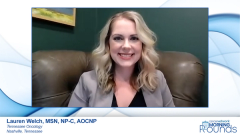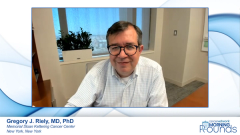
Chart Review 1: A 57-Year-Old Man With Advanced NSCLC
Centering discussion on a 57-year-old man with advanced NSCLC, panelists consider molecular testing strategies and the subsets of EGFR mutation.
Episodes in this series

Transcript:
Gregory J. Riely, MD, PhD: We’ll move next to a case. I’ll give you the thumbnail of the case, and we can talk about it at first. Then Jason, I’ll have you think a bit about the molecular testing, and then we’ll go through some initial treatment thoughts as well. A 57-year-old man presents with shortness of breath, chest pain, fatigue, and an unintentional 10-lb weight loss. The patient’s past medical history is otherwise unremarkable. He is a never smoker, with social alcohol use. He does live far away from the nearest cancer center and works full time. On physical exam, he has decreased breath sounds on the left side. A clinical evaluation with chest x-ray shows a left lower lobe mass. This is further evaluated with a CT scan of the chest, abdomen and pelvis that shows the left lower lobe mass is 4.3 cm. There’s mediastinal and hilar lymphadenopathy, as well as a left-sided adrenal metastasis. A PET [positron emission tomography] scan confirms that these sites are FDG [fluorodeoxyglucose]-avid. A brain MRI is negative for metastasis.
From a clinical-stage perspective, this is a T3 N3 M1 tumor. The patient has a good performance status, PS1. To get a tissue diagnosis, we sent the patient to our local pulmonologist, who does a bronchoscopy with transbronchial biopsy, and the tumor is sent for biomarker testing. What are we thinking about at this point? Let’s think first about molecular testing. Jason, when we have a patient with newly diagnosed cancer and their diagnostic procedure is a bronchoscopy, what does that often mean to you? I think my sense is that those are more often cytology specimens that you’re going to get from a bronchoscopy and EBUS [endobronchial ultrasound], and procedures like that. Is that right?
Jason Chang, MD: That’s right, yes. Sometimes we’ll have transbronchial biopsies, which are small fragments of bronchial tissue and hopefully surrounding tumor as well.
Gregory J. Riely, MD, PhD: Working off cytology, does that lead to any limitations for how you guys can approach both the diagnosis, but also molecular testing?
Jason Chang, MD: It’s not so much of a problem for diagnosis, per say. We often can make a diagnosis of malignancy, for example adenocarcinoma, on cytology specimens. However, we have to make sure we have sufficient tumor cells for molecular testing, which is another hurdle. We have investigated the sufficiency rate of molecular testing on cytology samples at MSK [Memorial Sloan Kettering Cancer Center], and based on our experience, it seems like over 90% of cytology samples would also be sufficient for our large panel NGS [next-generation sequencing] testing. That suggests that cytology samples are not inferior to surgical pathology samples.
Gregory J. Riely, MD, PhD: I would put the caveat there that it’s cytology samples that you’ve seen. There’s a difference between a single-pass fine needle aspirate [FNA], and the multiple passes of EBUS samples. Clearly, you need more than just a single-pass FNA to get a diagnosis and molecular testing.
Jason Chang, MD: Exactly. I also wanted to emphasize that, at MSK at least, we do rapid on-site evaluation of cytology sample sufficiency as well. So we can immediately tell the radiologist, interventional radiologist, or the pulmonologist doing the procedure whether the cytology samples are diagnostic. That helps with the sufficiency rate as well.
Gregory J. Riely, MD, PhD: This patient is a 57-year-old man, never smoker. What are the molecular alterations that are at the top of your list for ones to know the results for? Clearly, we’re going to try to test all of them because we try to test all of them in all patients. But what would you say the most common ones are in this context?
Jason Chang, MD: In this context, I would probably think about the alterations that are commonly associated with never-smoking status, which would be EGFR, ALK, and ROS1.
Gregory J. Riely, MD, PhD: Among EGFR, is there more than 1 type of EGFR mutation?
Jason Chang, MD: Definitely. EGFR activating mutations typically occur in exons 18 through 21. In general, when we talk about EGFR mutations, we think about the typical and the atypical mutations. The typical mutations that occur in about 85% of the cases are either EGFR exon 21 L858R mutations or the exon 19 deletions of various sizes. But those 2 combined will give you about 85% of the mutations, and those respond quite well to EGFR TKIs [tyrosine kinase inhibitors]. Then there are the atypical EGFR mutations such as the G719S or the L861Q, and those have variable responses to EGFR TKIs. Finally, we have the EGFR exon 20 insertions. Historically, those were thought to be somewhat resistant to EGFR TKIs until recently; there’s now an FDA-approved therapy for EGFR exon 20 insertion mutations.
I also wanted to quickly make the distinction that although there are other types of point mutations that occur on EGFR exon 20, such as T790m, those are entirely different from the EGFR exon 20 insertion mutations. On the molecular report, we have to specifically look at the class of the mutations.
Gregory J. Riely, MD, PhD: That’s really an important thing to highlight. Lauren and I as the consumers of these reports, we see EGFR mutation and we get excited, if it’s an exon 19 deletion or an exon 21 L858R. It’s important to look at the details of that and understand if there’s something different and something we need to know, like an exon 20 insertion or something that’s wouldn’t be necessarily a first-line treatment approach.
Transcript edited for clarity.
Newsletter
Stay up to date on recent advances in the multidisciplinary approach to cancer.

























































































